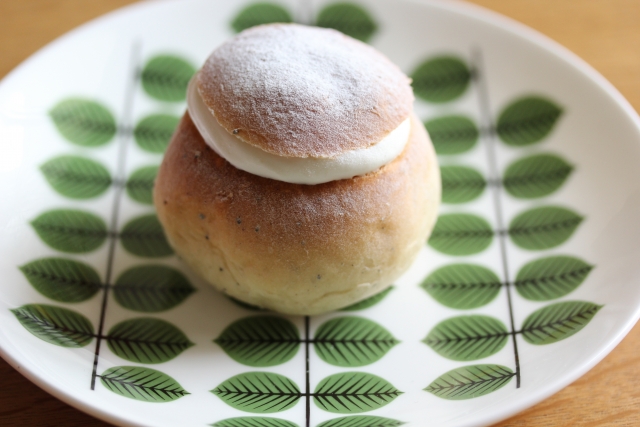Swedish bakeries sell semla, a small pastry similar to cream puffs.
It is a round bread with spices and plenty of creams.
Semla originated in 18th-century Sweden.
It has a history of being a pastry eaten the day before fasting during Easter.
In this article, I would like to explain the charm of semla, a popular Swedish pastry.
What kind of pastry is semla?

Semla is a palm-sized pastry that appears on the shelves of Swedish bakeries every January.
At first glance, Semla looks exactly like a cream puff.
The difference between semla and cream puffs is that while cream puffs are made of puff pastry, semla is made of cardamom flavored round bread with cream sandwiched in between.
Semla is a round loaf of bread hollowed out inside and filled with almond paste and whipped cream.
It may be more like a cream bun than a cream puff.
Semla is a Swedish pastry that represents the arrival of spring.
In Sweden, semla is sold in bakeries and cake stores all over town as soon as Christmas is over.
Ingredients for semla

Semla is a round loaf of bread cut into slices and served with almond paste and whipped cream.
In addition to the cream flavor, the bakery offers a variety of other flavors, including chocolate and blueberry.
The round bread used for semla has the spice cardamom kneaded into the dough.
https://hokuou-info.com/en/2021/03/24/cardamom/Cardamom belongs to the ginger family and is characterized by its aroma, which has been called the queen of spices.
When people think of spices, they usually think of curry.
However, in the Nordic countries, spices are used in a wide range of dishes other than curry, such as soups, meat dishes, and fish dishes.
It is therefore normal to add spices to bread.
And the way to eat semla is to hold it in your hand and eat it directly over your head, just as you would eat cream puffs.
If you are more conscious of manners, you can use the top dough like a spoon and scoop the cream with the dough.
Born in 18th century Sweden
It is believed that semla was first eaten in Sweden around the 18th century.
The first semla in Sweden was a simple round bread without cream.
In the 18th century, refined flour was a luxury.
Therefore, semla was only eaten as a pastry by a few aristocrats and wealthy people.
Meal on the day before Easter fasting
In mid-February, there is an event in Sweden called “Semla Day” where people eat semla and get excited about it.
Semla Day is also known as “Fettisdagen,” which means Fat Tuesday in Swedish.
The day of Semla used to be called “Shrove Tuesday,” the day before the start of the fast leading up to Easter.
In Christian countries, it was traditional to fast without food for the 40 days leading up to Easter, which is celebrated in early April each year.
Semla was originally a snack eaten the day before to provide calories for the long fast.

Semla is filled with cream and is a high-calorie snack compared to other sweets such as cookies.
Normally, one would be concerned about caloric overload with these snacks.
However, if it is the day before a fast, a little overeating may be acceptable.
Also, Semla was a pastry exclusively for the day before a fast, but today it is eaten in Sweden on a daily basis.
Conclusion
Semla used to be a calorie-replenishing food for the day before in preparation for the Easter fast.
Today, it is a popular Swedish sweet.





